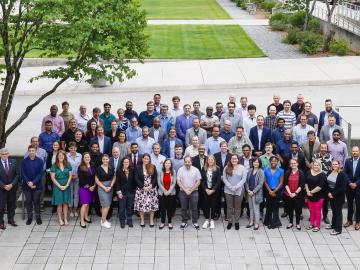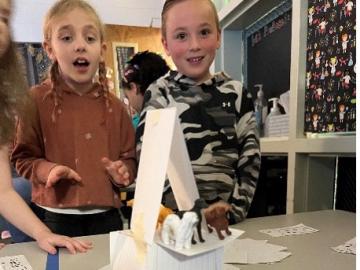
Filter News
Area of Research
- (-) Fusion and Fission (32)
- (-) National Security (45)
- Advanced Manufacturing (5)
- Biological Systems (1)
- Biology and Environment (102)
- Biology and Soft Matter (4)
- Building Technologies (2)
- Chemical and Engineering Materials (3)
- Chemistry and Physics at Interfaces (7)
- Clean Energy (168)
- Climate and Environmental Systems (7)
- Computational Biology (1)
- Computational Chemistry (5)
- Computational Engineering (1)
- Computer Science (3)
- Data (1)
- Earth Sciences (1)
- Electricity and Smart Grid (1)
- Energy Frontier Research Centers (7)
- Fuel Cycle Science and Technology (2)
- Functional Materials for Energy (8)
- Fusion Energy (7)
- Geographic Information Science and Technology (1)
- Isotopes (21)
- Materials (122)
- Materials for Computing (13)
- Materials Synthesis from Atoms to Systems (8)
- Materials Under Extremes (7)
- Neutron Data Analysis and Visualization (2)
- Neutron Science (72)
- Nuclear Science and Technology (27)
- Quantum Condensed Matter (3)
- Quantum information Science (4)
- Renewable Energy (2)
- Sensors and Controls (2)
- Supercomputing (153)
- Transportation Systems (4)
News Topics
- 3-D Printing/Advanced Manufacturing (4)
- Advanced Reactors (2)
- Artificial Intelligence (7)
- Big Data (4)
- Bioenergy (3)
- Biology (3)
- Biomedical (1)
- Biotechnology (1)
- Buildings (2)
- Chemical Sciences (2)
- Climate Change (4)
- Composites (1)
- Computer Science (10)
- Coronavirus (1)
- Cybersecurity (8)
- Decarbonization (3)
- Energy Storage (2)
- Environment (5)
- Exascale Computing (1)
- Frontier (1)
- Fusion (12)
- Grid (4)
- High-Performance Computing (5)
- ITER (2)
- Machine Learning (8)
- Materials (1)
- Materials Science (2)
- Nanotechnology (1)
- National Security (22)
- Net Zero (1)
- Neutron Science (2)
- Nuclear Energy (19)
- Partnerships (1)
- Physics (1)
- Quantum Science (1)
- Security (6)
- Simulation (3)
- Summit (1)
- Sustainable Energy (4)
- Transportation (1)
Media Contacts

When geoinformatics engineering researchers at the Department of Energy’s Oak Ridge National Laboratory wanted to better understand changes in land areas and points of interest around the world, they turned to the locals — their data, at least.

Experts across varied technology fields gathered ORNL to collaborate on the future of geospatial systems at the Trillion-Pixel GeoAI Challenge workshop. The third iteration of this event focused on multimodal advances in the field, including progress in artificial intelligence, cloud infrastructure, high-performance computing and remote sensing. These capabilities, when combined, can help solve problems in national and human security such as disaster response and land-use planning.

Tristen Mullins enjoys the hidden side of computers. As a signals processing engineer for ORNL, she tries to uncover information hidden in components used on the nation’s power grid — information that may be susceptible to cyberattacks.

As renewable sources of energy such as wind and sun power are being increasingly added to the country’s electrical grid, old-fashioned nuclear energy is also being primed for a resurgence.

Using disinformation to create political instability and battlefield confusion dates back millennia. However, today’s disinformation actors use social media to amplify disinformation that users knowingly or, more often, unknowingly perpetuate. Such disinformation spreads quickly, threatening public health and safety. Indeed, the COVID-19 pandemic and recent global elections have given the world a front-row seat to this form of modern warfare.

When virtually unlimited energy from fusion becomes a reality on Earth, Phil Snyder and his team will have had a hand in making it happen.

Four nuclear nonproliferation staff members from the Department of Energy’s Oak Ridge National Laboratory were recognized as part of the 2021 Outstanding Security Team awarded by the Secretary of Energy for contributions to the Material Control and Accountability Technical Qualification Program Pilot.

Nine engineers from ORNL visited 10 elementary and middle school classrooms in three school districts during National Engineers Week, Feb. 21 to 24, 2023, describing and demonstrating the excitement of the engineering profession to more than 300 Tennessee students.

Stephen Dahunsi’s desire to see more countries safely deploy nuclear energy is personal. Growing up in Nigeria, he routinely witnessed prolonged electricity blackouts as a result of unreliable energy supplies. It’s a problem he hopes future generations won’t have to experience.
The Autonomous Systems group at ORNL is in high demand as it incorporates remote sensing into projects needing a bird’s-eye perspective.


